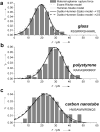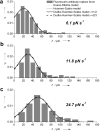Adhesion through single peptide aptamers
- PMID: 20795685
- PMCID: PMC4047793
- DOI: 10.1021/jp1031493
Adhesion through single peptide aptamers
Abstract
Aptamer and antibody mediated adhesion is central to biological function and is valuable in the engineering of "lab on a chip" devices. Single molecule force spectroscopy using optical tweezers enables direct nonequilibrium measurement of these noncovalent interactions for three peptide aptamers selected for glass, polystyrene, and carbon nanotubes. A comprehensive examination of the strong attachment between antifluorescein 4-4-20 and fluorescein was also carried out using the same assay. Bond lifetime, barrier width, and free energy of activation are extracted from unbinding histogram data using three single molecule pulling models. The evaluated aptamers appear to adhere stronger than the fluorescein antibody under no- and low-load conditions, yet weaker than antibodies at loads above ∼25 pN. Comparison to force spectroscopy data of other biological linkages shows the diversity of load dependent binding and provides insight into linkages used in biological processes and those designed for engineered systems.
Figures






Similar articles
-
In vitro selection of peptide aptamers with affinity to single-wall carbon nanotubes using a ribosome display.Biotechnol Lett. 2013 Jan;35(1):39-45. doi: 10.1007/s10529-012-1049-6. Epub 2012 Sep 18. Biotechnol Lett. 2013. PMID: 22986537
-
Solubilization of single-walled carbon nanotubes using a peptide aptamer in water below the critical micelle concentration.Langmuir. 2015 Mar 24;31(11):3482-8. doi: 10.1021/la504777b. Epub 2015 Mar 13. Langmuir. 2015. PMID: 25746134
-
Selection of a novel peptide aptamer with high affinity for TiO2-nanoparticle through a direct electroporation with TiO2-binding phage complexes.J Biosci Bioeng. 2016 Nov;122(5):528-532. doi: 10.1016/j.jbiosc.2016.04.003. Epub 2016 Apr 28. J Biosci Bioeng. 2016. PMID: 27133793
-
Peptide aptamers as guides for small-molecule drug discovery.Drug Discov Today. 2006 Apr;11(7-8):334-41. doi: 10.1016/j.drudis.2006.02.007. Drug Discov Today. 2006. PMID: 16580975 Review.
-
Peptide aptamers: development and applications.Curr Top Med Chem. 2015;15(12):1082-101. doi: 10.2174/1568026615666150413153143. Curr Top Med Chem. 2015. PMID: 25866267 Free PMC article. Review.
Cited by
-
Peptide aptamer identified by molecular docking targeting translationally controlled tumor protein in leukemia cells.Invest New Drugs. 2016 Aug;34(4):515-21. doi: 10.1007/s10637-016-0339-6. Epub 2016 Mar 14. Invest New Drugs. 2016. PMID: 26972431
-
Organophosphorus Flame Retardants and Metabolic Disruption: An in Silico, in Vitro, and in Vivo Study Focusing on Adiponectin Receptors.Environ Health Perspect. 2024 Nov;132(11):117003. doi: 10.1289/EHP14634. Epub 2024 Nov 8. Environ Health Perspect. 2024. PMID: 39514743 Free PMC article.
-
Single-molecule protein unfolding and translocation by an ATP-fueled proteolytic machine.Cell. 2011 Apr 15;145(2):257-67. doi: 10.1016/j.cell.2011.03.036. Cell. 2011. PMID: 21496645 Free PMC article.
-
The activated ClpP peptidase forcefully grips a protein substrate.Biophys J. 2022 Oct 18;121(20):3907-3916. doi: 10.1016/j.bpj.2022.08.042. Epub 2022 Aug 31. Biophys J. 2022. PMID: 36045571 Free PMC article.
-
Mechanochemical basis of protein degradation by a double-ring AAA+ machine.Nat Struct Mol Biol. 2014 Oct;21(10):871-5. doi: 10.1038/nsmb.2885. Epub 2014 Sep 7. Nat Struct Mol Biol. 2014. PMID: 25195048 Free PMC article.
References
Publication types
MeSH terms
Substances
Grants and funding
LinkOut - more resources
Full Text Sources
Miscellaneous

